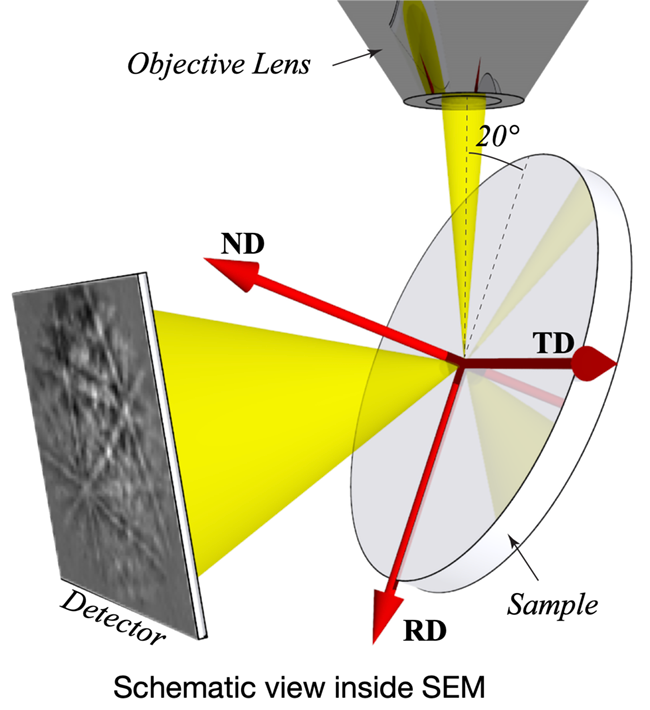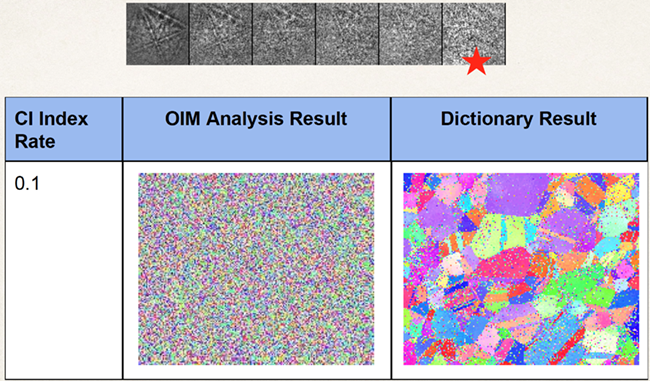CMU software aids materials scientists worldwide
Marc De Graef has developed a materials characterization software so powerful it can create orientation maps from low-quality materials.
Behind the equipment in the Materials Characterization Facility are software programs that can examine thousands of data points to build intricate models, automate routine analysis, and process high-definition images. This enables researchers to make advancements in modern materials development. After using third-party software for decades, Marc De Graef grew frustrated that in certain cases the software couldn’t provide clean and accurate results, so he began to develop his own routines. Today, his software is offered as part of a commercial package through EDAX—a leading provider of materials characterization systems.

Source: College of Engineering
Electron backscatter diffraction (EBSD) sends an electron beam onto a material sample and records a Kikuchi diffraction pattern.
Electron backscatter diffraction (EBSD) is a characterization technique that sends an electron beam onto a material sample and records a Kikuchi diffraction pattern. These patterns are a collection of bands in a 2D configuration that can be used to determine the orientation of a material’s crystal lattice. Software systems can analyze the crystal orientations as a function of position on the sample and create multi-colored images, known as orientation maps. These maps give material scientists new insights into the role of microstructure in materials’ behavior.
To produce high-quality maps using this technique, the material sample must be finely polished in order to locate the bands. Even with careful polishing, De Graef, a professor of materials science and engineering, and his students consistently ran into issues with the existing software “blacking out” areas of the map where both the material was low-quality and the Kikuchi patterns had a low signal-to-noise ratio. To improve this, De Graef worked with Al Hero, a signal processing expert and professor at the University of Michigan, to create a new method to index Kikuchi patterns.

Source: College of Engineering
DeGraef’s software (right) compared to existing software (left) displays a clearer image despite high pattern noise.
As part of the Air Force Multidisciplinary University Research Initiative in 2013, De Graef’s group began developing computational techniques; they further developed the techniques over the last five years with funding from the Office of Naval Research. De Graef and his students realized that by building a dictionary of all possible crystal orientations, they could predict the Kikuchi band patterns without needing to actually locate the bands. Therefore, if the material sample was low-quality, their software could still extract the crystal orientation from the pattern and create an accurate orientation map.
Compared to the existing software, De Graef’s algorithms are more robust against pattern noise and create orientation maps that are 80% more accurate. This improvement caught the attention of EDAX, a leading provider of materials characterization systems, and in 2021 they began offering this new approach, now called the dictionary indexing algorithm, as an add on to their existing software.
De Graef’s software has been extremely useful in more quickly evaluating new development ideas.
Stuart Wright, Senior EBSD Scientist, EDAX
Stuart Wright, a senior EBSD scientist with EDAX, believes that the software has been very beneficial to their support team to educate customers about the ambiguities that are inherent to EBSD characterization of certain material systems. “Not only is the software from De Graef’s group a benefit to our customers working with difficult to index samples, we have also found the ability to accurately simulate EBSD patterns using De Graef’s dynamic diffraction model extremely useful in testing and refining our existing software capabilities, as well as more quickly evaluating new development ideas.”
Additionally, EDAX is exploring another pattern-recognition algorithm developed by De Graef’s team that uses a cross-correlation approach to detect where an experimental diffraction pattern is located on the Kikuchi diffraction sphere; this approach is known as “spherical indexing” or “SphInx.”
